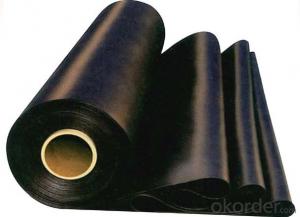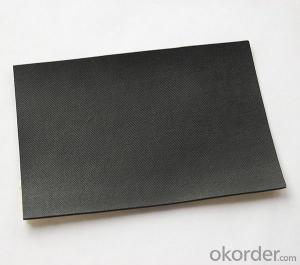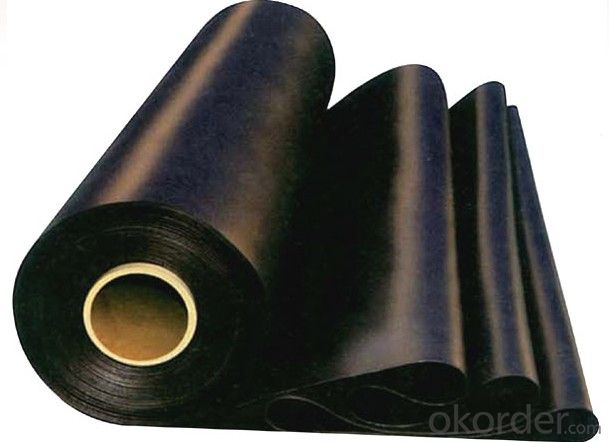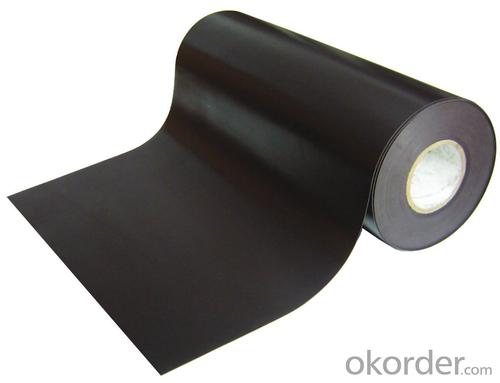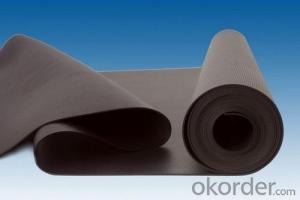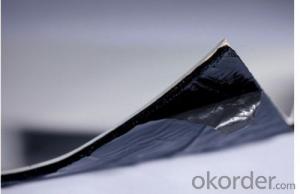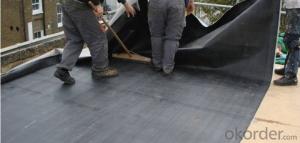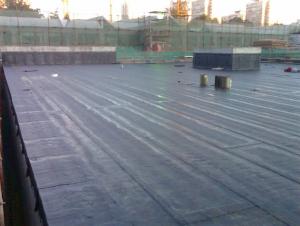EPDM High Polymer Waterproofing Membrane for Underground Roof
- Loading Port:
- China main port
- Payment Terms:
- TT OR LC
- Min Order Qty:
- 5000 m²
- Supply Capability:
- 100000 m²/month
OKorder Service Pledge
OKorder Financial Service
You Might Also Like
Introduction for EPDM Waterproofing Membrane:
It is a kind of self-adhesive waterproof coiled material based on polymer rubber and superior asphalt, together with polyethylene film and aluminum foil as surface material or no film(Double-sided self-adhesive). And it adopts the package preventing-adhesion-isolation-layer package, and dividing into no fiber and polyester fiber two parts.The coiled material has perfect performances, simple operation, non-pollution and etc.
Characteristic of EPDM Waterproofing Membrane:
1. High adhesive strength, durability, long after the bond;
2.Excellent weathering resistance, aging resistance;
3. Nano stabilizer added ingredients, low heat dimensional change;
4. High tensile strength, elongation, strong grass-roots stretching or cracking adaptability, resistance to low temperatures, can be adapted to -40 ℃;
5.Cold installation, easy to operate, reduce environmental pollution and improve working conditions of workers;
Specification of EPDM Waterproofing Membrane:
Item | Thickness(mm) | Width(mm) | Length(m) | Color |
1.0—2.0 | 1200 | 20 | Black | |
Deviation | -1 +15 | --1 | Multicolor |
FAQ of Waterproofing Membrane
a.Can we get some samples before place order?
Answer: We can send the free samples to you by freight collect.
b.How many years can your PVC membrane guarantee?
Answer: We will guarantee the quality for 5 years at least.
c.Which countries you ever export the product?
Answer: We export the PVC membrane to South Africa, Middle east and even European countries.
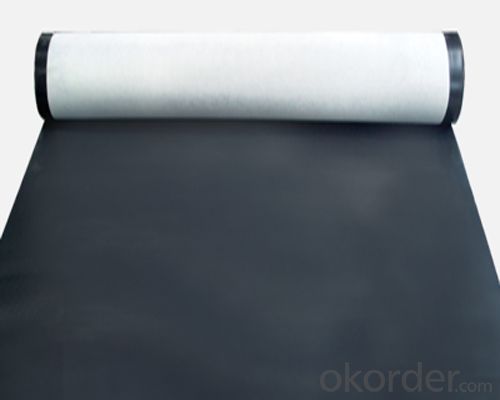
- Q: Can waterproofing membranes be used on concrete tanks?
- Yes, waterproofing membranes can be used on concrete tanks. Waterproofing membranes are commonly used to prevent water penetration and protect concrete structures from water damage. Concrete tanks, like other concrete structures, are susceptible to water infiltration over time, which can lead to deterioration and structural issues. Applying a waterproofing membrane on the concrete surface can effectively prevent water penetration, making the tank more durable and extending its lifespan. There are various types of waterproofing membranes available, such as liquid-applied membranes, sheet membranes, and cementitious coatings, each with its own advantages and suitability for different applications. It is important to choose the right type of waterproofing membrane based on factors like the tank's usage, exposure to water pressure, and environmental conditions. Additionally, proper surface preparation and application techniques are essential for ensuring the effectiveness and longevity of the waterproofing membrane on the concrete tank.
- Q: Can a waterproofing membrane be used on precast brick block surfaces?
- Yes, a waterproofing membrane can be used on precast brick block surfaces. The membrane acts as a barrier to prevent water penetration and can help protect the precast brick blocks from moisture damage.
- Q: Can a waterproofing membrane be used for historic preservation projects?
- Indeed, in the realm of historic preservation projects, a waterproofing membrane holds immense value. When it comes to safeguarding the original architecture and materials of historical buildings, extra care is often required. To prevent water damage, which ultimately leads to deterioration and decay, waterproofing membranes serve as a reliable solution. These membranes, designed with flexibility, durability, and longevity in mind, are perfectly suited for application on historic structures. By applying them to roofs, walls, and foundations, water infiltration is effectively prevented, ensuring the preservation of the building's structural integrity. However, it is of utmost importance to seek guidance from preservation experts and strictly adhere to appropriate preservation guidelines. This ensures that the utilization of a waterproofing membrane aligns with the building's historical significance and does not compromise its authenticity.
- Q: Are there any specific building code requirements for using a waterproofing membrane?
- Different jurisdictions have specific building code requirements when it comes to using a waterproofing membrane. These requirements often include certain standards that the membrane must meet, as well as instructions for its installation provided by the manufacturer. The building codes may specify the type of membrane to be used, its minimum thickness, and the method by which it should be installed. For instance, the International Building Code (IBC) mandates that waterproofing membranes must be listed and labeled by an approved testing agency. The code also demands that the membrane be installed in a way that offers continuous protection and can withstand expected structural movements and environmental conditions. Apart from the type and installation requirements, building codes may also outline the procedures for testing and inspecting waterproofing membranes. This is done to guarantee that the membrane is correctly installed and will effectively prevent moisture intrusion, thus safeguarding the building against potential damage and deterioration. To ensure compliance with these requirements and to have a waterproofing membrane that meets the necessary standards, it is crucial to consult the local building code or seek assistance from a qualified professional.
- Q: Can a waterproofing membrane be used for tunnels and underground structures?
- Tunnels and underground structures necessitate the use of a waterproofing membrane to combat water infiltration and safeguard against potential water damage. Such membranes are commonly employed in construction to create a barrier against water and are particularly vital in these situations due to the increased risk of water ingress from surrounding soil and groundwater. The integrity and longevity of the infrastructure rely on waterproofing membranes in these environments. Waterproofing membranes designed for tunnels and underground structures are specifically engineered to endure the unique challenges presented by these settings. Typically composed of resilient and flexible materials like bitumen, PVC, or EPDM, they effectively resist water pressure and provide long-lasting protection. Furthermore, these membranes are often reinforced with multiple layers or fabrics to enhance strength and resistance against punctures or tears. The meticulous process of applying waterproofing membranes in tunnels and underground structures involves thorough cleaning and preparation of surfaces such as walls and floors to ensure proper adhesion of the membrane. Multiple layers are then applied to achieve complete coverage and a seamless seal. Special attention is paid to critical areas such as joints, corners, and penetrations to eliminate potential weak points. The utilization of a waterproofing membrane effectively shields tunnels and underground structures from water intrusion, groundwater pressure, and potential moisture-induced damage. This preserves the structural integrity of the infrastructure, prevents water-related issues like leaks, corrosion, or deterioration, and guarantees the safety and functionality of the tunnel or underground facility.
- Q: Can a waterproofing membrane be used for water tanks or reservoirs?
- Yes, a waterproofing membrane can be used for water tanks or reservoirs. Waterproofing membranes are designed to create a barrier that prevents water from penetrating through the surface. They are commonly used in various applications, including water tanks and reservoirs, to ensure that the stored water remains contained and does not leak or seep into the surrounding environment. The membrane is typically applied on the interior surface of the tank or reservoir, providing a durable and watertight seal. This helps to maintain the integrity of the water storage system and prevent any potential water loss or contamination. Additionally, waterproofing membranes can also protect the tank or reservoir from corrosion and structural damage caused by water exposure, extending their lifespan. Therefore, using a waterproofing membrane is an effective solution for ensuring the safety and functionality of water tanks or reservoirs.
- Q: Can a waterproofing membrane be used for a foundation wall?
- A foundation wall can indeed utilize a waterproofing membrane. It is highly advisable to employ such a membrane to shield the foundation against water infiltration and moisture-related harm. Typically, this membrane is applied on the outer side of the foundation wall, serving as a barrier to prevent water from penetrating. Its design entails flexibility, durability, and resistance to hydrostatic pressure, thereby ensuring long-lasting protection for the foundation. Moreover, the membrane aids in preventing water from seeping into the basement or crawl space, thereby decreasing the risk of mold, mildew, and structural problems. Ultimately, employing a waterproofing membrane for a foundation wall is an effective means of safeguarding the building's foundation, guaranteeing its integrity and longevity.
- Q: Does a waterproofing membrane require any protective coatings or sealants?
- No, a waterproofing membrane typically does not require any additional protective coatings or sealants as it is designed to be a standalone barrier against water penetration.
- Q: Can a waterproofing membrane be installed by a homeowner or is professional installation required?
- Although a homeowner can technically install a waterproofing membrane, it is strongly advised to enlist the services of a professional. Several factors must be taken into consideration, making professional installation the superior choice. To begin with, proper installation of waterproofing membranes necessitates specific knowledge and expertise. Professionals are trained in the correct techniques and possess experience working with various membrane types. They understand the intricacies of the process, including surface preparation, membrane application, and sealing. This expertise guarantees correct installation and effective waterproofing. Furthermore, professionals have access to top-quality materials and tools that homeowners may not readily have access to. They possess knowledge of which membrane type is appropriate for various applications and can recommend the best product based on individual needs. Additionally, professionals have access to specialized equipment, enabling more efficient and effective installation. In addition, professional installation offers the advantage of warranties and guarantees. Reputable waterproofing companies typically provide warranties for their services, providing homeowners with peace of mind. They can trust that any issues that arise will be addressed and resolved by the professionals. Lastly, waterproofing is essential for safeguarding homes against water damage and maintaining structural integrity. Improper installation or a faulty membrane can lead to water leaks, mold growth, and expensive repairs. By hiring a professional, homeowners can be confident that the waterproofing membrane will be installed correctly, reducing the risk of future problems. In conclusion, while it is possible for homeowners to install waterproofing membranes themselves, the complexities of the process and the advantages of professional installation make it highly recommended to hire a professional for this task. Their expertise, access to quality materials, warranties, and guarantees provide homeowners with the reassurance that the job will be carried out correctly and effectively, ultimately protecting their homes from water damage.
- Q: Can a waterproofing membrane be used on foam block surfaces?
- Yes, a waterproofing membrane can be used on foam block surfaces. Foam blocks, such as expanded polystyrene (EPS) or extruded polystyrene (XPS), are often used as insulation in buildings. However, foam blocks are not inherently waterproof and can absorb moisture if left unprotected. To prevent water infiltration and potential damage, a waterproofing membrane can be applied to the foam block surfaces. The membrane acts as a barrier, preventing water from seeping into the foam and protecting it from moisture-related issues such as mold, mildew, or degradation. It is important to select a waterproofing membrane that is compatible with foam block surfaces and follow the manufacturer's instructions for proper application. Additionally, it is recommended to consult with a professional or a building engineer to ensure the appropriate waterproofing solution is chosen for the specific foam block application.
Send your message to us
EPDM High Polymer Waterproofing Membrane for Underground Roof
- Loading Port:
- China main port
- Payment Terms:
- TT OR LC
- Min Order Qty:
- 5000 m²
- Supply Capability:
- 100000 m²/month
OKorder Service Pledge
OKorder Financial Service
Similar products
Hot products
Hot Searches
Related keywords
